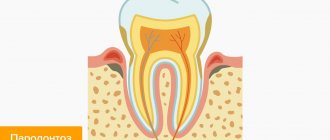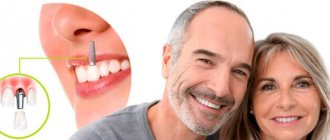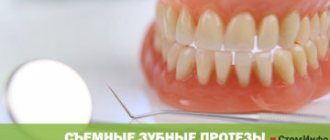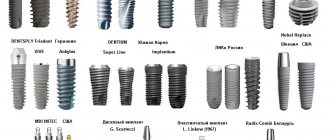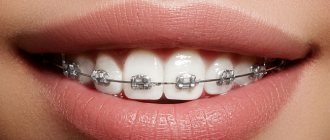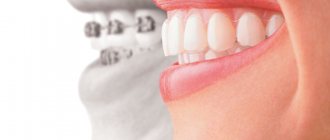What it is?
An overdenture is a type of conditionally removable structure that fits tightly to the gums, teeth, soft or hard palate . It completely covers the area of the alveolar process, roots, bases for attachment and can be removed at any time independently or with the help of a dentist.
This type of dental restoration can be used for both partial and complete absence of teeth.
The covering prosthesis consists of several basic parts:
- artificial crowns that completely replicate the anatomy and bite of natural teeth;
- support base onto which the crowns are attached;
- fixing mount , for installation on the gum.
A cover-type prosthesis is not intended for simultaneous fixation on a living tooth and an implant, since they have different mobility.
Fixation methods
The method of fixation also affects the appearance of the prosthesis and its cost. There are several ways to fix overdentures.
- Clasps.
Metal or non-metal hooks that wrap around the body of the supporting tooth and help the denture stay in the mouth. Currently, metal hooks are practically not used due to the risk of damage to the enamel and an allergic reaction. - Attachmen.
Mini-clasps, one part of which is installed on the prosthesis itself, and the other is glued to the supporting teeth. A more modern and aesthetic solution. - Telescopic crowns.
Caps that cover the supporting teeth, after which the prosthesis is installed. This option is more expensive (largely due to the complex procedure for preparing supporting teeth) and is used quite rarely. - Implants.
In case of complete absence of teeth, the best solution would be to install an overdenture on implants. The prosthesis can be installed on a beam - a special structure that connects the implants and provides better load distribution. The second option is attachments that have a spherical shape. The snap-in concept is also implemented here. Most often, attachments are used for mini-implantation. Mini-implants are implanted into the mucous membrane and do not require a certain amount of bone. They cannot carry a fixed prosthesis, so the doctor places a removable overdenture, which is fixed on attachments. In classical implantation, a full overdenture is usually recommended as a temporary solution, but in some cases it is used on a permanent basis.
Advantages and disadvantages
When choosing this type of restoration, you should pay special attention to its positive and negative aspects.
Advantages :
- covering structures are well suited for people with a strong gag reflex. This is ensured by a small basic foundation that does not require much getting used to;
- when used, a strong fixation is guaranteed, preventing the structure from falling out and there is no need to remove it while sleeping;
- The prosthesis is designed in such a way that it can be installed in cases of extensive bone atrophy, since the pressure on the jaw is distributed evenly. Thanks to this same property, the risk of injury to the gums is minimized;
- are characterized by durability and long service life.
Flaws:
- any covering type of structure has a long manufacturing period associated with the complexity of combining elements;
- Several components are used for manufacturing, so the final price can be very high.
How are teeth numbered in dentistry, what schemes are used?
We suggest you read reviews about Lumineers here.
Follow the link: - prices for Sensodyne toothpaste are shown.
Care
To increase the service life of the overdenture and maintain its aesthetic appearance, dentists recommend adhering to the following recommendations:
- Perform hygiene procedures at least twice a day using a soft bristled brush and non-abrasive toothpaste;
- rinse the denture with water after each meal and use special disinfectants every day;
- after removing the prosthesis, store it in a special liquid;
- visit the dentist every six months to examine the condition of the oral cavity and dentures.
Indications and contraindications
The use of overdentures, like any other structures intended for restoration and restoration of the dentition, has certain indications and contraindications.
Their installation is carried out according to the following indications:
- edentia (complete or partial absence of crowns) of one or both jaws;
- bone tissue atrophy, precluding the use of a standard removable prosthesis;
- poor stability of the remaining teeth, which cannot be used as support;
- pronounced gag reflex.
The use of structures of this type is contraindicated if the patient has pathologies or conditions that in any way affect the structure of soft and bone tissues and lead to rejection of the prosthesis.
These include:
- diabetes;
- thyroid diseases;
- period of pregnancy and breastfeeding;
- malignant formation;
- poor blood clotting;
- diseases caused by infection, occurring in an acute form.
Kinds
Cover-type dentures have their own classification. Basically, the division into types is made according to three parameters: coverage area - full and partial are distinguished, material of manufacture, method of fixation .
Full and partial
The design can be made both for the restoration of a small area of the dentition, and for its complete restoration. Depending on this, the following types are distinguished:
Partial
Photo: partial construction
They can be used if one or more strong, stable, fully preserved teeth remain. Partial teeth rest mainly on healthy teeth , evenly distributing the load between them and the gums.
Externally, the design is often compared to a bridge-type prosthesis . The installation is also carried out in the absence of one or two adjacent teeth. This does not require preparation of adjacent crowns.
Most often in this case, a butterfly prosthesis . This design is especially in demand for restoring chewing crowns.
Full
Photo: full structure
This type is installed in the complete absence of crowns and roots. They rest solely on the gum and are characterized by a larger coverage area, occupying almost the entire palate.
This type of restoration has one feature: the stability of the structure depends only on the chosen method of fixation. As a rule, the more reliable the fixation elements, the more expensive their cost.
Manufacturing materials
To make overdentures in dentistry, several materials are used that differ in appearance, cost and physical characteristics:
- Acrylic .
This is a type of high-strength plastic. It holds its shape well and is the most accessible material due to its low cost. But acrylic has its drawbacks: it is short-lived and quickly loses its appearance. The design of this material is rigid and takes a long time to get used to. In addition, acrylic dentures require careful care. - Nylon .
The use of nylon allows you to accurately replicate the topography of the area being restored. The elasticity of the material makes the design as comfortable as possible to wear, reducing the risk of gum chafing and significantly shortening the period of adaptation. Nylon is hypoallergenic and therefore suitable for people with allergic reactions. It is used only for making the base. What it successfully copes with due to its high resistance to mechanical stress. The main disadvantage is the high cost. - Metal. This material is not the main one in the manufacture of prostheses. As a rule, only base reinforcements are made from it, allowing the structure to last for more than ten years.
The metal beams and arcs from which the frame is made act as amplifiers. For this purpose, a durable titanium alloy is used.The use of a metal frame makes it possible to reduce the area of direct exposure of the material to soft tissue. Metal has a small drawback - it does not have an aesthetic appearance.
All of the listed materials cannot be called ideal for prosthetics, so prosthetics are often made in combination.
Fixation methods
A large number of different elements are used for fixation:
Clasps
Photo: clasp design
These are metal branches in the form of hooks extending from the main frame. Used when installing a prosthesis with one or two adjacent crowns. The branches make it easy to remove and put on the structure, but have a drawback - the metal wire stands out against the background of natural crowns.
Attachmen
Photo: Attachments close-up
They are micro-locks, one part of which is installed on the crowns of the preserved teeth, and the other directly on the prosthesis. At the moment of contact, the locks snap into place. This mechanism provides reliable fixation and is the most popular.
Telescopic crowns
Photo: design on telescopic crowns
In this case, fixation is carried out using a double artificial crown. One part of it is fixed on the tooth stump, the second on the structure. With a little pressure, the prosthesis is firmly fixed in the mouth.
Implants
Photo: implant-based design
The most preferable, but also expensive option. When installing implants, two types of fastening are used: push-button and beam.
- With push-button fixation, abutments with a spherical head are screwed into the implants, which protrudes slightly above the gum. Fastening occurs by inserting the spherical head into the silicone matrix of the prosthesis, inserted into the recesses.
- With beam fastening, a cast beam is installed in the implants, which, like the first option, is inserted into a silicone matrix. To install such fixing elements, no more than three implants are required.
The following video will show a design on implants with ball-shaped abutments, used for complete edentia:
Cable prosthetics
Dental bridges, as is known, are not only supported, but also suspended, the basis of which is a tensioned cable. Inspired by this design, Dr. Alexander Nikolaevich Ryakhovsky developed and in 1999 patented a new design - cable-stayed prosthesis .
It is based on armid thread, which is 8 times stronger than steel. It passes inside the artificial tooth and covers the perimeter of the supporting teeth, connecting them together into a single block. The thread is fixed with cement. In this case, the supporting teeth do not need to be ground down for crowns; it is only necessary to saw through the enamel a little, making small indentations for the thread.
The cable-stayed prosthesis is made in two visits. During the first visit, the doctor prepares the teeth and takes impressions; during the second, he tries on and installs the prosthesis. Cable-stayed structures are less durable than traditional cermet bridges, but they are cheaper. In addition, they are good for patients with loose teeth - the cable system allows them to be secured.
A budget option for prosthetics for loose teeth is a cable-stayed prosthesis. Prosthetics in dentistry is a vast industry and today offers dozens of solutions that the modern dentist is guided by. What does "modern" mean? A specialist who masters new technologies and techniques, constantly studies and practices a lot. Make an appointment with our doctors by phone: +7 (495) 971-97-97,
Adhesive prostheses
Another option for gentle fastening is adhesive prostheses. Tiny cavities are machined into the supporting teeth, into which the supporting inlays of the prosthesis are attached using light-curing cement. The second halves of the fastening are located on the prosthesis. When installed, the fasteners snap into place and are cemented for added strength. The entire procedure for creating a tooth takes only 2-3 hours. True, such a prosthesis will last only 1.5-3 years, and it will not be possible to replace a large defect. If desired, the adhesive prosthesis can be removed and the cavities on healthy teeth can be filled
| Name of service | Price, rub.) |
| initial visit - examination and consultation | for free |
| re-examination and consultation | 500 |
| certificate of reorganization | 500 |
| Removable prosthetics | |
| Complete removable acrylic denture | 26000 |
| Complete removable denture made of monomer-free material | 32000 |
| Partial removable acrylic denture with metal clasps | 24000 |
| Nylon clasp prosthesis | 32000 |
| Splinting clasp prosthesis | 36000 |
| Clasp denture with locks (the composition includes locks + a set of teeth manufactured by Imp) | 50000 |
| Nylon butterfly prosthesis (from 1 to 3 teeth) | 15000 |
| Repairing removable dentures | |
| Repair of prosthetic fracture | 4000 |
| Welding one tooth | 2000 |
| Welding of each subsequent tooth | 500 |
| Full metal clasp | 1500 |
| Relining a removable denture | 3000 |
| Cleaning a removable denture | 500 |
| Restoration of old dentures (re-welding of teeth, relining) (1 jaw) | 10000 |
| Correction of removable dentures | 500 |
| Removing the post stump | 6000 |
| Fixed dental prosthetics | |
| Metal-ceramic crown (frame base nickel-chrome) | 10500 |
| Metal-ceramic crown with shoulder mass (cobalt-chrome frame base) | 12000 |
| Ceramic crown on a zirconium oxide (zirconium dioxide) frame | 21000 |
| Full zirconium crown Prettau Zirconium | 24000 |
| All-metal crown (cobalt chrome) | 4000 |
| Plastic crown | 2000 |
| Stump inlay (cobalt chrome) | 5000 |
| Core inlay (zirconium oxide) | 7500 |
| Removing a crown on a cast frame | 700 |
| Removing the stamped crown | 500 |
| Cementing a crown not made in our clinic | 500 |
| Implant supported prosthetics | |
| Metal-ceramic crown supported by an implant, frame base (cobalt chromium) | 14500 |
| Implant-supported ceramic crown, frame base (zirconium dioxide) | 22500 |
| Veneers | |
| production of veneer using the direct method (cost depends on the clinical situation) | 5000-12000 |
| first degree of difficulty | 5000 |
| second degree of difficulty | 6000 |
| third degree of difficulty | 7000 |
| fourth degree of difficulty | 10000 |
Manufacturing and installation stages
Carrying out covering prosthetics requires careful diagnosis and preparation. First of all, dental pathologies of dental and periodontal tissue are eliminated.
And only after this they begin the prosthetic procedure, which is carried out in several stages:
- Taking impressions using alginate mass from both jaws of not yet prepared crowns.
- Grinding and shaping of teeth and roots . Repeated impression taking with silicone mass.
- Installation of temporary crowns or temporary prosthesis (if required).
- Making a prosthesis . At this stage, a plaster model is cast from the resulting casts, according to which the main structure is molded.
- Fitting and fitting of the prosthesis . If at the fitting stage the design causes discomfort, then it is corrected.
- Fixation . When the structure is completely suitable, without causing pain or discomfort, a small grinding of the surface of the crowns is carried out and fixing elements are installed. After which the entire structure is completely installed.
If prosthetics require implantation, then before installing overdentures, you must wait until they are completely implanted. Typically this period lasts from 2 to 6 months.
Prices
The cost of prosthetics with covering structures is quite high, since this restoration method requires detailed processing of each component element.
So how much does an overdenture cost? If we consider the average cost, the prices for each type of structure will be as follows:
| View | price, rub. |
| Nylon full | from 25 thousand |
| Nylon partial (3 teeth or more) | from 20 thousand |
| Nylon partial (1–3 teeth) | from 10 thousand |
| Metal one-sided with clasps | from 20 thousand |
| Metal one-sided on attachments | from 30 thousand |
| Acrylic full | from 10 thousand |
| Acrylic partial (1–2 teeth) | from 3 thousand |
| Acrylic on implants with spherical fixation (2 implants per 1 jaw) | from 70 thousand |
| Acrylic on implants with beam fixation (2 implants per 1 jaw) | from 80 thousand |
Let's talk about the structure of the human tooth and find out all its features.
In this article we will explain how to treat flux with antibiotics.
Follow the link: - Swiss Curaprox toothbrushes reviewed.
Price of covering dentures
The cost of a covering prosthesis largely depends on the treatment concept, design and material from which it is made. If we are talking about complete removable dentures, then the price for them starts from 15,000 rubles: for this amount you will get a regular plastic denture. If we are talking about nylon prostheses or products made of acrylic-free plastic, then the cost can easily reach up to 50,000 rubles for a full covering prosthesis (for example, AcryFree). Implant-supported overdentures will be even more expensive, especially if they are bar-retained. The cost here ranges from 60,000 to 100,000 rubles and also depends on the level of the clinic where the treatment takes place.
Reviews
Overlay prosthetics is a fairly popular method of restoring the dentition, as it allows you to select the necessary material and components, focusing on their cost and quality.
If you have experience using overdentures, you can share your feedback in the comments to this article.
If you find an error, please select a piece of text and press Ctrl+Enter.
Tags dentures prosthetics removable dentures
Did you like the article? stay tuned
